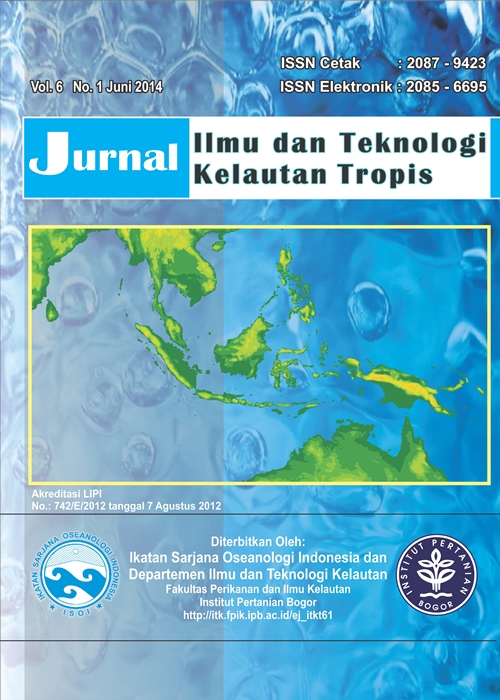THE ADDITION OF Ulva reticulata AS A STIMULANT INTO ARTIFICIAL FEED ON THE GONAD CONDITION OF THE COLLECTOR SEA URCHIN (Tripneustes gratilla LINNAEUS 1758)
Abstract
Dried Ulva reticulata has been proven as a feeding stimulant for the collector sea urchins (Tripneustes gratilla). The purposes of this study were to determine the optimal dose of dried U. reticulata as a feeding stimulant into artificial feed and its effect on the gonad condition of the collector sea urchins, T. gratilla. Previously, starved sea urchins (ca. 66 mm diameter, n=7) was held in 80-l aquarium volume with flow through seawater system (6.25 l/hour inlet and outlet). Sea urchins were fed with diet containing 0, 10, 20, or 30% of dried U. reticulata (designated control, U-10, U-20, and U-30 respectively) ad libitum for 38 days. Each treatment was given 3 replicates. Survival rate, feed consumption, and gonad conditions (gonad index, biochemical composition of the gonad, gonad histology, and egg diameter) parameters were quantified and compared to sea urchins fed with the mixture of fresh macroalgae (Gracilaria lichenoides and Padina) and seagrass (Enhalus acoroides). The results showed that the addition of dried U. reticulata into artificial feed by 10% from feed weight (U-10) was the optimal dose recommended. Sea urchins treated U - 10 diet resulted in gonad index and egg diameter (5.02 % and 82.66 µm each), were higher than other diet treatments. However, this diet treatment was not able to homogenize the reproductive phase composition of T. gratilla.
Keywords: Ulva reticulata, Feeding Stimulant, Tripneustes gratilla, Gonad Condition
Authors
The author submitting the manuscript must understand and agree that the copyright of the article manuscript must be submitted/transferred to the Jurnal Ilmu dan Teknologi Kelautan Tropis. This work is licensed under the Creative Commons Attribution-ShareAlike 4.0 (CC BY-SA) International License in which the Author and Reader can copy and redistribute the material in any media or format, and remix, modify and build material for any purpose, but they must provide appropriate credit (citing articles or content), provide a link to the license, and indicate whether there is a change. If you mix, change, or create material, you must distribute your contribution under the same license as the original.


